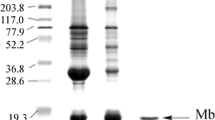Summary
A sea turtle myoglobin has been spin labelled in the cyanomet form (MbT-CN) with a maleimide spin label and temperature-induced changes were monitored by EPR. The EPR spectrum is composed by an immobilized and a more mobile signal. Comparison of this spectrum with spectra obtained from other proteins, blocking of the NH2-terminal and titration of SH groups lead to the conclusion that a reactive histidine is involved in the spin labelling. Our results on the temperature-induced changes monitored by the maleimide spin label suggest that a sequence of events is taking place in the transition which leads to protein denaturation (predenaturation): with increase in temperature atpH 8.5 the EPR parameter for the immobilized signal (α EPR) is the first to report the structural change (T 1/2=28°C); then the mobile signal changes (T 1/2=44°C) and finally the active centre monitored by optical absorption of the iron heme undergoes these changes (T 1/2=64°C). The activation energy calculated from the mobile spectrum is around 3 kcal/mol showing that these changes are quite subtle if compared to the enthalpy changes monitored by optical absorption of iron (40 kcal/mol). This predenaturation occurring in the range (30÷50)°C seems to be a general property of myoglobins, as has been observed also for whale and applysia.
Riassunto
La mioglobina di tartaruga marina è state marcata con spin label maleimida nella forma cianometa (MbT-CN) e cambiamenti di temperatura sono stati indotti e accompagnati per EPR. Lo spettro di EPR è composto da un segnale fisso e un’altro piú mobile. Comparazioni di questo spettro con altri ottenuti da altre proteine, bloccando l’NH2 terminale e titolando il gruppo SH, mettono in evidenza che un’istidina reattiva partecipa alla marcazione dello spin label. I nostri risultati nei cambiamenti di temperatura indotti e accompagnati dallo spin label indicano che la sequenza di fatti ha indotto una transizione che porta alla denaturazione della proteina (predenaturazione): con aumento della temperature apH=8.5, il parametro di EPR per il segnale fisso (α EPR) è il primo a rivelare il cambiamento strutturale (T 1/2=28°C), allora il segnale mobile si modifica (T 1/2=44°C) e infine il centro attivo accompagnato per l’assorbimento ottico del ferro subisce questo cambiamento (T 1/2=64°C). L’energia di attivazione calcolata per lo spettro mobile è intorno di 3 kcal/mol indicando che questo cambiamento è piccolo quando comparato con la variazione di entalpia ottenuta per l’assorbimento ottico del ferro (40 kcal/mol). Questa predenaturazione che avviene nella fascia da 30 a 50°C sembra essere una proprietà comune delle mioglobine, come è stato osservato anche per la mioglobina di balena e di aplisia.
Резюме
В миоглобин морской черепахи вводится спиновая метка в форму (MbT-CN) и методом EPR контролируются термоиндуцированиые изменения. Спектр EPR составляют неподвижные и более подвижные сигналы. Сравнение этого спектра со спектрами других белков, блокирование концевой NH2-группы и титрование SH-групп приводит к выводу, что помечены активные гистидины. Наши результаты по наблюдению за термоиндуцированными изменениями дают возмож-ность предположить, что имеет место последовательность событий в процессе перехода, который приводит к денатурации белка (пред-денатурация): с увеличением температуры приpH=8.5 параметр EPR для неподвижного сигнала (α EPR) первым регистрирует структурное изменение (T 1/2=28°C); затем изменяется подвижный сигнал (T 1/2=44°C) и, наконец, претерпевает изменения активный центр, который мониторируется за счет оптического поглощения в железе (T 1/2=64°C). Энергия активации, вычисленная на основе подвижного спектра, составляет примерно 3 ккал/моль. Это указывает на то, что указанные изменения являются весьма тонкими по свавнению с изменениями энтальпии, которая мониторируется за счет оптического поглощения в железе (40 ккал/моль). Эти явление пред-денатурации, которое наблюдается в области (30÷50)°C, по видимому, представляет общее свойство миоглобинов.
Similar content being viewed by others
References
L. J. Berliner (Editor):Spin Labelling Theory and Applications (Academic Press, New York, N. Y., 1976).
G. I. Likhtenstein:Spin Labelling Methods in Molecular Biology (John Wiley and Sons, New York, N.Y., 1976).
Methods in Enzymology, Vol.49 (Academic Press, New York, N.Y., 1978).
P. Ascenzi, S. G. Condo, A. Bellelli, D. Barra, W. H. Bannister, D. Giardina andM. Brunori:Biochem. Biophys. Acta,788, 281 (1984).
M. W. Neal andJ. R. Florini:Anal. Biochem.,55, 328 (1973).
J. M. Manning: inMethods in Enzymology, Vol.76 (Academic Press, New York, N.Y., 1981).
S. Ohnishi, J. C. A. Boyens andH. M. McConnell:Proc. Natl. Acad. Sci. USA,56, 809 (1966).
M. Tabak: Docent Thesis, University of São Paulo, São Carlos (1982).
G. Acampora andJ. Hermans Jr.:J. Am. Chem. Soc.,89, 1543 (1967).
B. P. Atanasov:Nature (London),233, 560 (1971).
M. Tabak, O. R. Nascimento andJ. C. Say:FEBS Lett.,40(2), 241 (1982).
Author information
Authors and Affiliations
Rights and permissions
About this article
Cite this article
Baffa, O., Tabak, M., Nascimento, O.R. et al. Temperature-induced conformational changes in turtle myoglobin. Il Nuovo Cimento D 7, 139–150 (1986). https://doi.org/10.1007/BF02451237
Received:
Issue Date:
DOI: https://doi.org/10.1007/BF02451237




